
The Kawasaki Ninja 250R is a motorcycle in the Ninja sport bike series from the Japanese manufacturer Kawasaki originally introduced in 1986. As the marque's entry-level sport bike, the motorcycle has undergone few changes throughout its quarter-century lifetime, having received only three substantial redesigns. In some markets the Ninja 250R has been succeeded by the Ninja 300.

The Kawasaki GPZ900R is a motorcycle that was manufactured by Kawasaki from 1984 to 2003. It is the earliest member of the Ninja family of sport bikes. The 1984 GPZ900R was a revolutionary design that became the immediate predecessor of the modern-day sport bike. Developed in secret over six years, it was Kawasaki's and the world's first 16-valve liquid-cooled inline four-cylinder motorcycle engine.

Universal Japanese Motorcycle (UJM) is a term for Japanese standard motorcycles coined in the 1970s. It referred to motorcycles made by Japanese manufacturers that made motorcycles more accessible to common people. It commonly refers to Japanese motorcycles made for commuting with a four-stroke and inline four-cylinder engine. By around 1990 its popularity began to wane as the market fragmented into more specialized designs.
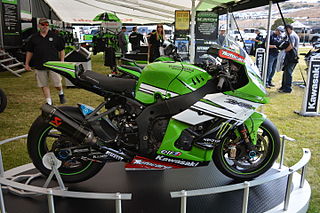
The Kawasaki Ninja ZX-10R is a motorcycle in the Ninja sport bike series from the Japanese manufacturer Kawasaki, the successor to the Ninja ZX-9R. It was originally released in 2004 and has been updated and revised throughout the years. It combines an ultra-narrow chassis, low weight, and radial brakes. In 2004 and 2005 the ZX-10R won Best Superbike from Cycle World magazine, and the international Masterbike competition.
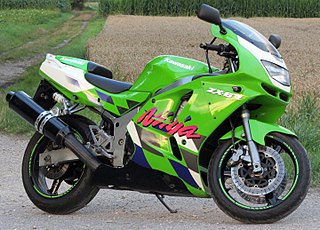
The Kawasaki Ninja ZX-6R is a 636 cc class motorcycle in the Ninja sport bike series from the Japanese manufacturer Kawasaki. It was introduced in 1995, and has been constantly updated throughout the years in response to new products from Honda, Suzuki, and Yamaha. The ZX series is what was known as the Ninja line of Kawasaki motorcycles in the 1980s and still carries the name today.

The ZZR1400 or Kawasaki Ninja ZX-14 and ZX-14R (2006–2022), is a motorcycle in the Ninja sport bike series from the Japanese manufacturer Kawasaki that was their most powerful sport bike as of 2006. It was introduced at the 2005 Tokyo Motor Show and released for the 2006 model year as a replacement for the Kawasaki ZZ-R1200 (2002-2005). The ZZR1400 is capable of accelerating from 0–60 mph in 2.5 seconds. The top speed is electronically limited to 186 mph (299 km/h) as a result of an agreement between the major Japanese and European motorcycle manufacturers.
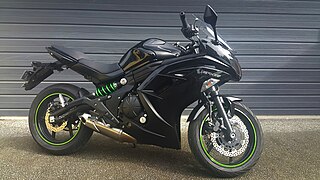
The Kawasaki Ninja 650R, also called ER-6f or EХ-6, is a motorcycle for in the Ninja series from the Japanese manufacturer Kawasaki sold since 2006. The 2012 model drops the R suffix from its name. It is a middleweight, parallel-twin engined motorcycle, designed for normal use on paved roads. They have modern styling and features, with low-seating ergonomics and a low center of gravity. The engine has a 180° crankshaft, resulting in an uneven firing interval of 0° and 540°.
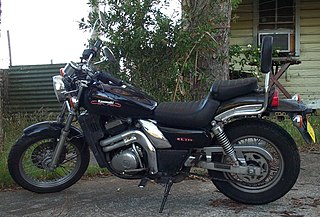
The Kawasaki Eliminator is a cruiser-type motorcycle that has been produced in several variants since its introduction in 1985 as the 900 Eliminator. Currently billed as a "power cruiser", the first two versions of the bike, namely the 1985 Eliminator and 1986 ZL900 models, were almost street replicas of a drag style bike, featuring shaft drive, the ZX900 close-ratio gearbox and forward seating. The engine for both of these machines was the same motor available in the 900ccm Ninja of the same year, albeit with different exhaust and intake configurations.

The Suzuki GS500 is an entry level motorcycle manufactured and marketed by the Suzuki Motor Corporation. Suzuki produced the GS500 and GS500E from 1989 on and the fully faired model, GS500F from 2004 on. The GS500 is currently being produced and sold in South America. The GS500 has been described in the motorcycle literature as a best buy and an excellent first bike, with adequate if not exciting power for more experienced riders.
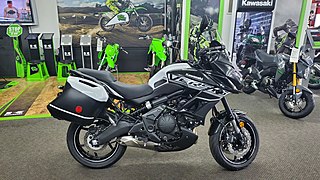
The Kawasaki Versys 650 is a middleweight motorcycle. It borrows design elements from dual-sport bikes, standards, adventure tourers and sport bikes; sharing characteristics of all, but not neatly fitting into any of those categories. The name Versys is a portmanteau of the words versatile and system. It was introduced by Kawasaki to the European and Canadian markets as a 2007 model and to the US market in 2008. A California emissions compliant version was released in 2009. In 2010 new styling was applied to the headlight and fairings and several functional changes made including enlarged mirrors and improved rubber engine mounts. In 2015, a new model was introduced with a new fairing style that abandoned the older, stacked headlights for the more conventional twin headlight style commonly found on sportbikes.

The Kawasaki Z1 is a four-cylinder, air-cooled, double-overhead camshaft, carbureted, chain-drive motorcycle introduced in 1972 by Kawasaki. Following the introduction of Honda's CB750 in 1968, the Z1 helped popularize the in-line, across-the-frame four-cylinder, a format that became known as the Universal Japanese Motorcycle or UJM.

The ZZ-R1100 or ZX-11 is a sport bike in Kawasaki's Ninja series made from 1990 to 2001, as the successor to the 1988–1990 Tomcat ZX-10. With a top speed of 272–283 km/h (169–176 mph), it was the fastest production motorcycle from its introduction until 1996, surpassed by the 270–290 km/h (170–180 mph) Honda CBR1100XX. It was marketed as the ZX-11 Ninja in North America and the ZZ-R1100 in the rest of the world. The C-model ran from 1990 to 1993 while the D-model ran from 1993 to 2001, when it was replaced by the ZZ-R1200 (ZX-12C) 2002-2005
Kawasaki Heavy Industries Motorcycle & EngineCompany (川崎重工業モーターサイクル&エンジンカンパニー) is a division of Kawasaki Heavy Industries that produces motorcycles, ATVs, utility vehicles, jet ski personal watercraft, and general-purpose petrol engines. Before the 2011 fiscal year it was called Consumer Products & Machinery. Its slogan is "Let the good times roll!"

The Kawasaki Ninja 1000 SX is a motorcycle in the Ninja series from the Japanese manufacturer Kawasaki sold since 2011. Other than its name, it is unrelated to the Ninja 1000R produced from 1986–89, or to other Ninja motorcycles.

The Honda CBR250R, CBR300R and CB300F are lightweight 249.5–286 cc (15.23–17.45 cu in) displacement single-cylinder motorcycles made by Honda since 2011.

The Kawasaki Ninja 300, or EX300, is a 296 cc (18.1 cu in) Ninja series sport bike introduced by Kawasaki in 2012 for the 2013 model year. It is sold in Asia, Australia, Europe, and North America. When introduced, the Ninja 300R replaced the Ninja 250R in some markets, and in others they were sold alongside each other. When the 2018 model year Ninja 400 was introduced, it replaced the 300 in some markets.

The Kawasaki Ninja H2 is a "supercharged supersport"-class motorcycle in the Ninja sports bike series manufactured by Kawasaki, featuring a variable-speed centrifugal supercharger.

The Kawasaki Ninja 400 is a 399 cc Ninja series sport bike introduced by Kawasaki in 2018 originally. It was then recreated as a successor to the Ninja 300. It launched with the 2018 model year.
The Kawasaki Ninja 125 is a motorcycle in the Ninja sport bike series from the Japanese manufacturer Kawasaki that was introduced in 2018. It is powered by a 125 cc (7.6 cu in) single-cylinder engine that produces a claimed 11 kW (15 hp).

















